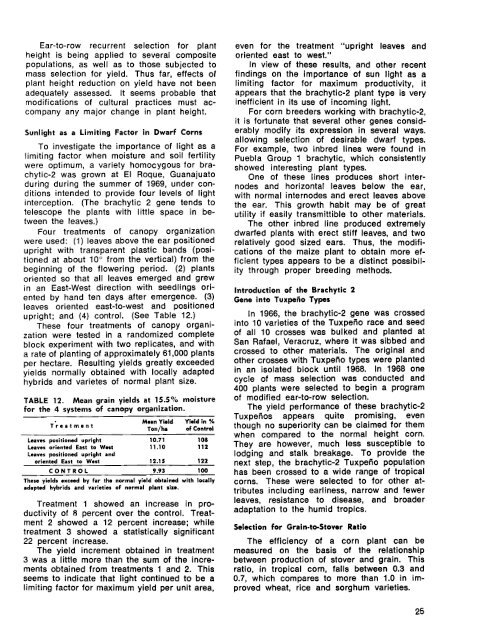REPORT - Search CIMMYT repository
REPORT - Search CIMMYT repository
REPORT - Search CIMMYT repository
You also want an ePaper? Increase the reach of your titles
YUMPU automatically turns print PDFs into web optimized ePapers that Google loves.
Ear-to-row recurrent selection for plant<br />
height is being applied to several composite<br />
populations, as well as to those subjected to<br />
mass selection for yield. Thus far, effects of<br />
plant height reduction on yield have not been<br />
adequately assessed. It seems probable that<br />
modifications of cultural practices must accompany<br />
any major change in plant height.<br />
Sunlight as a Limiting Factor in Dwarf Corns<br />
To investigate the importance of light as a<br />
limiting factor when moisture and soil fertility<br />
were optimum, a variety homocygous for brachytic-2<br />
was grown at EI Roque, Guanajuato<br />
during during the summer of 1969, under conditions<br />
intended to provide four levels of light<br />
interception. (The brachytic 2 gene tends to<br />
telescope the plants with little space in between<br />
the leaves.)<br />
Fou r treatments of canopy organization<br />
were used: (1) leaves above the ear positioned<br />
upright with transparent plastic bands (positioned<br />
at about 10° from the vertical) from the<br />
beginning of the flowering period. (2) plants<br />
oriented so that all leaves emerged and grew<br />
in an East-West direction with seedlings oriented<br />
by hand ten days after emergence. (3)<br />
leaves oriented east-to-west and positioned<br />
upright; and (4) control. (See Table 12.)<br />
These four treatments of canopy organization<br />
were tested in a randomized complete<br />
block experiment with two replicates, and with<br />
a rate of planting of approximately 61,000 plants<br />
per hectare. Resulting yields greatly exceeded<br />
yields normally obtained with locally adapted<br />
hybrids and varietes of normal plant size.<br />
TABLE 12. Mean grain yields at 15.5% moisture<br />
for the 4 systems of canopy organization.<br />
Treatment<br />
Meen Yield<br />
Ton/he<br />
Yield In %<br />
of Control<br />
Leaves positioned upright<br />
Leaves oriented East to West<br />
10.71<br />
11.10<br />
108<br />
112<br />
Leaves positioned upright and<br />
oriented East to West 12.15 122<br />
CONTROL 9.93 100<br />
These yields exceed by far the normal yield obtained with locally<br />
adapted hybrids and varieties of normel plent size.<br />
Treatment 1 showed an increase in productivity<br />
of 8 percent over the control. Treatment<br />
2 showed a 12 percent increase; while<br />
treatment 3 showed a statistically significant<br />
22 percent increase.<br />
The yield increment obtained in treatment<br />
3 was a little more than the sum of the increments<br />
obtained from treatments 1 and 2. This<br />
seems to indicate that light continued to be a<br />
limiting factor for maximum yield per unit area,<br />
even for the treatment "upright leaves and<br />
oriented east to west."<br />
In view of these results, and other recent<br />
findings on the importance of sun light as a<br />
limiting factor for maximum productivity, it<br />
appears that the brachytic-2 plant type is very<br />
inefficient in its use of incoming light.<br />
For corn breeders working with brachytic-2,<br />
it is fortunate that several other genes considerably<br />
modify its expression in several ways.<br />
allowing selection of desirable dwarf types.<br />
For example, two inbred lines were found in<br />
Puebla Group 1 brachytic, which consistently<br />
showed interesting plant types.<br />
One of these lines produces short internodes<br />
and horizontal leaves below the ear,<br />
with normal internodes and erect leaves above<br />
the ear. This growth habit may be of great<br />
utility if easily transmittible to other materials.<br />
The other inbred line produced extremely<br />
dwarfed plants with erect stiff leaves, and two<br />
relatively good sized ears. Thus, the modifications<br />
of the maize plant to obtain more efficient<br />
types appears to be a distinct possibility<br />
through proper breeding methods.<br />
Introduction of the Brachytic 2<br />
Gene into Tuxpefio Types<br />
In 1966, the brachytic-2 gene was crossed<br />
into 10 varieties of the Tuxpeno race and seed<br />
of all 10 crosses was bulked and planted at<br />
San Rafael, Veracruz, where it was sibbed and<br />
crossed to other materials. The original and<br />
other crosses with Tuxpeno types were planted<br />
in an isolated block until 1968. In 1968 one<br />
cycle of mass selection was conducted and<br />
400 plants were selected to begin a program<br />
of modified ear-to-row selection.<br />
The yield performance of these brachytic-2<br />
Tuxpenos appears quite promising, even<br />
though no superiority can be claimed for them<br />
when compared to the normal height corn.<br />
They are however, much less susceptible to<br />
lodging and stalk. breakage. To provide the<br />
next step, the brachytic-2 Tuxpeno population<br />
has been crossed to a wide range of tropical<br />
corns. These were selected to for other attributes<br />
including earliness, narrow and fewer<br />
leaves, resistance to disease, and broader<br />
adaptation to the humid tropics.<br />
Selection for Grain·to-Stover Ratio<br />
The efficiency of a corn plant can be<br />
measured on the basis of the relationship<br />
between production of stover and grain. This<br />
ratio, in tropical com, falls between 0.3 and<br />
0.7, which compares to more than 1.0 in improved<br />
wheat, rice and sorghum varieties.<br />
25

















